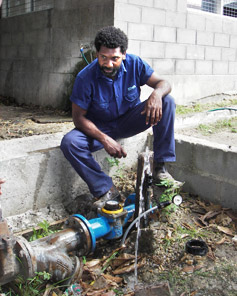What is Water Demand Management?
 A common characteristic of water demand in urban areas worldwide is its relentless rise over many years, and projections of continuous growth over coming decades. The chief influencing factors are population growth, together with changes in lifestyle, demographic structure and the possible effects of climate change. The detailed implications of climate change are not yet clear, and anyway will depend on global location, but must at least increase the uncertainty in security of supply. This is compounded by rapid development, creeping urbanisation and, in some places, rising standards of living.
A common characteristic of water demand in urban areas worldwide is its relentless rise over many years, and projections of continuous growth over coming decades. The chief influencing factors are population growth, together with changes in lifestyle, demographic structure and the possible effects of climate change. The detailed implications of climate change are not yet clear, and anyway will depend on global location, but must at least increase the uncertainty in security of supply. This is compounded by rapid development, creeping urbanisation and, in some places, rising standards of living.Meeting this increasing demand from existing resources is self-evidently an uphill struggle, particularly in water stressed or water scarce regions, in the developed and developing world alike. There are typically two potential responses; either ‘supply-side’, meeting demand with new resources or ‘demand side’, managing consumptive demand itself to postpone or avoid the need to develop new resources. Worldwide there is considerable pressure from the general public, regulatory agencies, and some governments to minimise the impacts of new supply projects (e.g. building new reservoirs or inter-regional transfer schemes), implying the emphasis should be shifted towards managing water demand by best utilising the water that is already available.
The limited and costly options of developing new water resources for the Pacific urban areas has already made many governments adopt to the approach of water conservation. Water demand management involves the adoption of policies or investment by a water utility to achieve efficient water use by all members of the community. A demand management plan may involve a wide range of demand management measures including:
*
 cost-reflective pricing;
cost-reflective pricing;* universal customer metering;
* reticulation leakage detection and repair programs and pressure reduction;
* a communication strategy, including a community education campaign;
* customer advisory services, the use of incentives for installation and/or retrofitting of water efficient equipment;
* reduction of water use by the water utility;
* regulation of the efficiency of water using appliances, especially in new buildings;
* use of reclaimed water (e.g. waste water/grey water) to reduce the need for fresh water supplies;
* water use restrictions, either on a temporary pr permanent basis.
Demand management measures can be short or long term depending on the needs of the community served by the water utility. Measures which have a short lead-time are for instance restrictions, drought pricing and retrofitting programs. Others such as pricing structure reform, leakage detection and repair and regulation of the water efficiency of new buildings are longer-term measures.
Strategic planning is a key aspect of a successful demand management strategy. This means understanding the constraints, analyzing how much water is used, when, by whom, for what purpose and at what level of efficiency; determining the potential reduction in water use that can occur through improvements to water-using equipment and behavior and developing programs to achieve these improvements.
Economic evaluation of demand management measures is important to ensure that cost-effective measures are implemented. The sequence in which measures are implemented is also important. For instance it is not possible to establish a fair and efficient pricing system for water unless all customers are metered.
References: Butler, D. and Fayyaz M., Eds (2006): Water Demand Management. IWA Publishing, London. - & White, S., Ed., (1998): Wise Water Management: A Demand Management Manual for Water Utilities, (WSAA Research Report No. 86), Water Services Association of Australia.

















